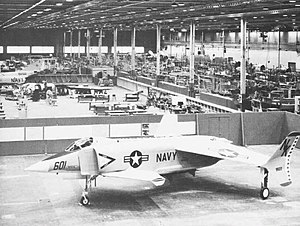Rockwell XFV-12
| Rockwell XFV-12 | |
|---|---|
 Mock-up of an XFV-12A |
|
| Type: | VTOL - fighter plane |
| Design country: | |
| Manufacturer: | |
| First flight: |
Never happened |
| Commissioning: |
Development canceled in 1981 |
| Production time: |
Was never mass-produced |
| Number of pieces: |
2 |
The North American Rockwell XFV-12 was a supersonic VTOL fighter project intended for use by the US Navy . North American Aviation's draft NR-356 opposed 10 other proposals. B. the Convair Model 200 belonged through. Development of the XFV-12 began in 1972 and was intended as a complement to the AV-8 Harrier . This should then be used exclusively for air-to-ground missions, whereas the XFV-12 was intended for airspace security. Like the Harrier, the XFV-12 was to be stationed on amphibious assault ships .
A total of two prototypes were built, the second never being fully completed. Neither of the two machines ever completed a flight. The first soil tests were carried out with the first prototype in July 1977. The first weight problems emerged. The first prototype was officially presented on August 26, 1977. During the levitation test in 1978 it became clear that the XFV-12 would not achieve the desired thrust-to-weight ratio of 1.5. Various design changes have been proposed and alternative engines with greater thrust have been sought. However, this would have led to further increases in weight, which is why the XFV-12 program was ended in 1981. The task of airspace security was initially left open. When the British Sea Harriers were able to prevail against the much faster Dassault Mirage III fighters in the Falklands War in 1982 , it was decided to also place the airspace security under the Harrier. The AV-8B Harrier II Plus was developed for this task .
Technical specifications
| Parameter | Dates (planned) |
|---|---|
| length | 13.40 m |
| span | 8.69 m |
| Normal takeoff weight | 8,850 kg |
| Maximum takeoff weight | 9,072 kg |
| Top speed | Mach 2.2 (at optimal altitude) |
| crew | 1 |
| Engine | A Pratt & Whitney F401-PW-400 turbofan engine |
| thrust |
|
| Thrust-to-weight ratio | 1.5 (with normal takeoff weight) |
| Armament |
|
Web links
Individual evidence
- ^ Steve Markman, Bill Holder: Straight up - a history of vertical flight , 2000, p. 126